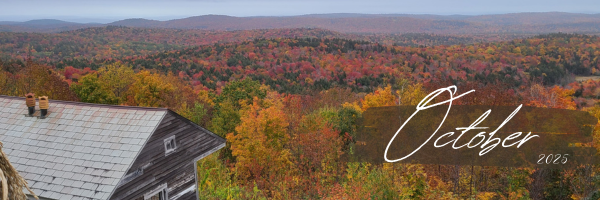
“October is the month for painted leaves.... As fruits and leaves and the day itself acquire a bright tint just before they fall, so the year near its setting. October is its sunset sky; November the later twilight.”
— Henry David Thoreau, "Autumnal Tints"
It's Time to Plant Garlic!
October is the month to plant garlic! This easy to grow vegetable is planted now, hibernates in the ground over the winter, and is ready for harvest come early summer. Garlic is often propagated via cloning. A single clove will form an entire bulb, which will then be broken apart and the process starts over again. Here are some tips for growing:
-
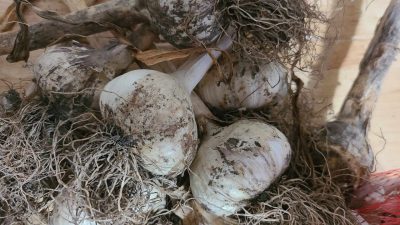
Photo by H. Zidack, UConn Home & Garden Education Center Look for hardneck varieties of garlic, as they are best suited to the New England Climate.
- Some softneck varieties are hardy, but do not plant cloves from the grocery store. Commercially grown garlic usually comes from California or China, and is not adapted to our New England climate. Produce sold in stores may also be treated with growth inhibitors which will prevent sprouting.
- Break up the garlic bulb, but do not peel the cloves before putting them in the ground - their skin is meant to protect the tender tissue inside, which stores energy for the next season.
- Plant cloves with the pointy side up in loose soil, at a depth of 1 to 3 inches, depending on the variety and size of the clove.
- Provide 6-8 inches of spacing between cloves.
- Cover your bed with a straw or leaf mulch to help insulate the new bulbs.
As the Garden Winds Down...
By October, many gardeners are ready to put their gardens to bed, or at least put parts of their gardens to bed. Here's a few helpful tips to help you tuck in those vegetable gardens!
- Before cleaning up your garden for the season, make a quick sketch or diagram of where you planted various crops. Use this as a reference next spring so you can practice crop rotation strategies. This is also a useful disease prevention technique against pathogens which overwinter in the soil.
- Add notes about what varieties were successful and what suffered to help you with seed selection this winter!
- Remove entire plants. Dispose of any leaves and plant material that were infected by disease, or heavily infested by insect pests. Compost only healthy plant material to help prevent the spread of problems next season.
- Clean up any dropped fruit to prevent volunteers next spring. (Or leave them for a fun experiment!)
- Save seeds from matured flowers and fruit for next year's garden
- Consider having your soil tested this fall to be ready to ammend as soon as spring kicks off next year!
- Find a way to cover the soil. If you have not already planted cover crops or winter vegetables, you can use healthy leaves, straw, or mulch to help keep your garden soil covered to prevent erosion during the winter.
- Pro Tip: Shred leaves before using them as mulch to help them break down faster
Sooty Blotch and Fly Speck on Apples
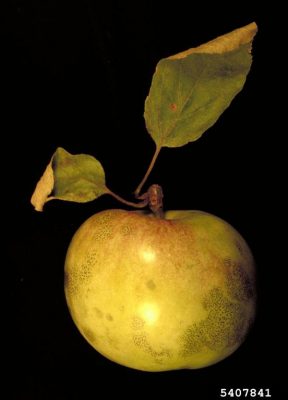
Seeing fruit that looks less than stellar while apple picking this fall? Sooty blotch and fly speck, interesting group of fungi that affect apple, may be to blame.
Sooty blotch causes brown, grey, or black smudges on an apple’s surface that can be easily wiped off. While clusters of small black dots on the apple’s external surface, more difficult to clean off than sooty blotch, are likely due to an infection of fly speck. Several different fungi can cause Sooty Blotch and Flyspeck, and these two issues may appear together or separately.
Fortunately, these concerns are only "skin deep" as they say. Apples that have been infected by either of these diseases are perfectly safe to eat, although their aesthetic value has been diminished. You can use apples of this nature to make treats such as apple butter, apple cider, or applesauce.
Native Plant: New England Aster
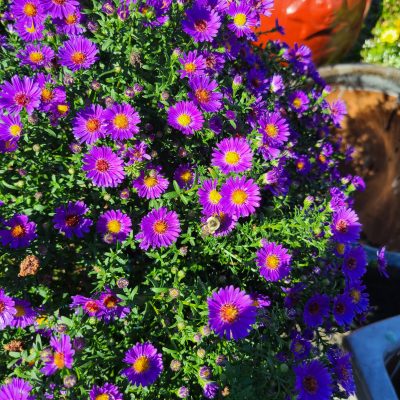
An excellent choice for late-season beauty for your garden is the New England aster, a Connecticut-native perennial with notable ecosystem benefits. This plant produces daisy-like flowers in brilliant shades of violet starting in late August and continuing through October. They fit perfectly in pollinator gardens, rain gardens, or as accent plants in a landscape.
This plant is extremely hardy. It can tolerate a wide range of conditions and soil types, from full sun to partial shade, and dry to wet ground conditions. They grow in USDA Plant Hardiness Zones 3 to 8 (https://planthardiness.ars.usda.gov/). In addition, they are resistant to many pests and diseases and may offer worthy competition against the weeds in your garden.
During the late growing season, many pollinators rely on the New England Aster as one of the few remaining sources of pollen and nectar, especially the migrating Monarch butterflies. Including this species in your garden will promote beneficial insects and pollinators to your garden from late summer through late fall, helping them thrive when their food sources become scarce.
New England Asters can grow to be between 3 and 5 feet in height and produce rough, velvety leaves. From early to late fall, they form clumps of vibrant flowers. Their natural habitat includes areas with open ground and high moisture, including prairies, lake shores, and wet meadows. They’re also often found on roadsides or along railroads, a testament to their hardiness and resilience.
Word from the WiSE
Women in Soil Ecology, UConn Student Chapter
Load Your Logs: Mushroom Cultivation
This month, UConn’s Women in Soil Ecology brings you a word on mushroom cultivation. Have you ever thought you were able to grow food from agricultural waste? Logs make a great environment to grow your own mushrooms!
Is it expensive to grow desired strains? Not really! It depends on how much you want to grow, and which mushrooms. Just remember these principles:
- Different mushrooms have different requirements; some like specific types of wood better than others - know your mushroom species beforehand.
- Reduce Competition: There are a lot of microorganisms in the environment looking for food, some of them like the same food your desired mushrooms do, or they would even like to eat your desired mushrooms! To avoid competition, you should sterilize your tools with 70% alcohol. Some fungicultors recommend using the log as it comes and some would recommend rinsing them with hot water before inoculation. You may want to increase the inoculum (the amount of mushroom you put to grow) when you are not in a sterile environment to improve chances of success.
- Monitor Humidity: mushrooms require between 70-75% humidity in their substrate (the place where they grow). When the log is fresh, the amount of water is considered ideal, but you should keep irrigating at least once per day.
- Mushrooms are not plants, they don’t need light to grow; in fact, they don’t like light when growing. Keep your logs under shade.
Kits are readily available for novice home cultivators. Remember, never consume or cultivate mushrooms that are not properly identified as many species can be toxic!
Always remember to be cautious but enthusiastic as you keep learning about fungi!
By Paulette Goyes, Soil Science and Mycology Ph.D. student
In the Garden & Pest Alerts
UConn Pest Alerts
During the growing season, UConn Extension publishes a regular pest alert for both vegetable and fruit producers. Additionally, the New England Vegetable Management Guide offers a lot of information about specific vegetable crops.
While the target audience for these publications is usually commercial growers, home gardeners can learn a lot from these materials including identification and management of common pests in your veggie gardens!
If you ever need confirmation on an ID or have additional questions about what you read in these reports, please do not hesitate to reach out to us at the Home & Garden Education Center! We're happy to help your gardens thrive.
Knowledge to Grow On
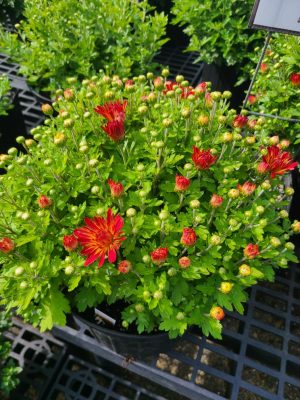
Read our Ladybug blogs written weekly:
Selecting Chrysanthemums for Beauty All Season Long
Fall Selections Beyond the Mum
Upcoming Events and Things to Do
- Scarecrows on Main, Old Wethersfield, CT
- Connecticut Garlic & Harvest Festival, Oct 11-12, Bethlehem, CT
- Check out a local corn maze, haunted house or other halloween events!
Educational Opportunities & Workshops
- Natures Buds- October 9, Hampton, CT
- 60 years/60 Trees: Nut & Deciduous, Oct 14, Stamford CT
- Spooky Creatures: Fact or Fright?, October 25, Derby, CT
- Attend a UConn Master Gardener Course! (Various dates and various locations)
Supplement Your Garden Produce with CT Grown Products!
Connecticut is rich in agricultural history, with many operational farms that have lots to offer local markets!
Supporting local CT Agriculture is a way that gardeners can supplement the fresh foods they grow in their garden, with seasonal offerings from year round operations.
Consider attending a local farmers market, joining Community Supported Agriculture (CSA's), or even stopping by your nearest farm stand to see what they have to offer!
October Gardening Tips
- Dig and store tender bulbs, corms, rhizomes, and tubers in a cool, dark, place.
- Keep collecting matured seeds. Dry them out and place them in labeled brown coin envelopes within an air tight container, and store in a cool place.
- When finding an indoor location for houseplants that have been out all summer, keep plants away from drafts, vents and sources of heat
- Examine houseplants carefully for insect pests before bringing them back inside. Give them a good grooming if necessary. You may want to spray plants with insecticidal soap after hosing off the foliage. Let the plants dry first.
- Beets, parsnips, and carrots can be covered with a thick layer of straw or leaves and left in the ground for harvest, as needed, during the winter. This may not be an option in areas with heavy vole populations.
- Prune fall-bearing raspberries after harvest.
- If rain is lacking, continue to thoroughly water trees, shrubs, planting beds, and lawn areas. It is especially important to keep newly planted evergreens watered
- Keep lawn areas seeded in September well-watered
- Use a mulching blade to chop leaves finely and let them decompose on the lawn
- Outwit hungry squirrels and chipmunks by planting bulbs in established groundcovers.
- Drain garden hoses and store in a shed, garage, or basement for the winter. Turn off all outside faucets.
This Month’s Newsletter Contributors:
Heather Zidack, Emily Leahy, Holly McNamara, Paulette Goyes, Dr. Nick Goltz

